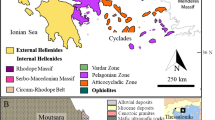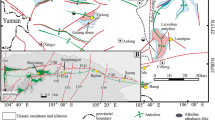Summary
The cobalt-arsenide ores of Bou Azzer are located along the borders of serpentinite massifs (Upper Proterozoic ophiolite complex) in carbonate-quartz lenses resulting from hydrothermal carbonate alteration of serpentinite. The cobalt ores contain an average gold content of 5–20 ppm; gold is mainly located in skutterudite (120 ppm av.), whereas the Fe-arsenide (loellingite) contains < 1 ppm Au. Similarly the highest PGE contents are found in skutterudite (up to 2 ppm total PGE). All the arsenide ores of Bou Azzer exhibit the same chondrite normalized PGE pattern displaying positive Rh and negative Pt anomalies, and a slight positive slope (Pd/Ir = 1 to 2). This uncommon PGE pattern closely resembles to that of sulphides of komatiites.
In serpentinite, the PGE patterns are typical of slightly depleted mantle rocks, and the associated podiform chromitites are within the range of ophiolitic chromitites, except for Pd and Au enrichment.
Horizons of sulphide-bearing serpentinites show relatively high contents of noble metals and display PGE patterns which closely resemble those of the Co-arsenide ores, although an order of magnitude lower. These sulphides probably correspond to the remobilization during serpentinization of primary magmatic sulphides. The sulphiderich horizons are a possible source-rock for the noble metals of the Bou Azzer cobaltarsenide ores.
Zusammenfassung
Die Kobalt-Arsenid Erze von Bou Azzer kommen entlang den Grenzen eines Serpentinit-Massifs (Oberproterozoischer Ophiolit-Komplex) in Karbonat-Quarz-Linsen vor, die auf hydrothermale Umwandlung des Serpentinits zurückgehen.
Die Kobalt-Erze enthalten 5–20 ppm Gold; dieses kommt hauptsächlich in Skutterudit (120 ppm) vor, während die Fe-Arsenide (Loellingit) weniger als 1 ppm Gold enthalten. Die höchsten PGE Gehalte kommen ebenso in Skutterudit vor (bis zu 2 ppm PGE). Alle Arsenid-Erze zeigen das gleiche Verteilungsbild mit positiven Rh und negativen Pt Anomalien, und eine leicht positive Neigung (Pd/Ir = 1 bis 2). Diese ungewöhnlichen PGE Verteilungsbilder erinnern an die von Sulfiden aus Komatiiten.
Die PGE Verteilung in Serpentiniten ist typisch für leicht verarmte Mantelgesteine, und die assoziierten podiformen Chromitite liegen innerhalb des Bereiches für ophiolitische Chromitite, mit Ausnahme der Anreicherung in Pd und Au.
Lagen von Sulfid-führenden Serpentiniten zeigen relativ hohe Gehalte an Edelmetallen, und PGE-Verteilungsmuster die denen von Co-Arseniderzen sehr ähnlich sind, obwohl sie um eine Größenordnung niedriger liegen. Diese Sulfide dürften Produkte der Remobilisierung primärer magmatischer Sulfide während der Serpentinisierung sein. Die Sulfid-reichen Lagen sind als ein mögliches Ursprungsgestein für die Edelmetalle der Kobalt-Arsenid-Erze von Bou Azzer zu sehen.
Similar content being viewed by others
References
Amossé J, Fischer W, Allibert M, Piboule M (1986) Méthode de dosage d'ultratraces de platine, palladium, rhodium et or dans les roches silicatées par spectrophotometrie d'absorption atomique électrothermique. Analysis 14 (1): 26–31
Barnes SJ, Naldrett AJ, Gorton MP (1985) The origin of the fractionation of platinum-group elements in terrestrial magmas. Chem Geol 53: 303–323
——Boyd R, Korneliussen A, Nilsson LP, Pedersen RB, Robins B (1988) The use of normalization and metal ratios in discriminating between the effects of partial melting, crystal fractionation and sulphide segregation on platinum-group elements, gold, nickel and copper: examples from Norway. In:Prichard HM, Potts PJ, Bowles JFW, Cribb SJ (eds) Geoplatinum 87. Elsevier Applied Science, London, pp 113–144
Buisson G, Leblanc M (1986) Gold bearing listwaenites (carbonatized ultramafic rocks) in ophiolite complexes. In:Gallagher MJ, Ixer RA, Neary CR, Prichard HM (eds) Metallogeny of basic and ultrabasic rocks. The Institution of Mining and Metallurgy, London, pp 121–132
—— —— (1987) Gold in mantle peridotites from Upper Proterozoic ophiolites in Arabia, Mali, and Morocco. Econ Geol 82: 2091–2097
Fischer W, Amossé J, Leblanc M (1988) PGE distribution in some ultramafic rocks and minerals from the Bou Azzer ophiolite complex (Morocco). In:Prichard HM, Potts PJ, Bowles JFW Cribb SJ (eds) Geoplatinum 87. Elsevier Applied Science, London, pp 199–210
Foose MP, Economou M, Panayiotou A (1985) Compositional and mineralogic constraints on the genesis of ophiolite hosted nickel mineralization in the Pevkos area, Limassol Forest, Cyprus. Mineral Deposita 20: 234–240
Hansen M, Anderko K (1958) Constitution of Binary Alloys, vol. 1, McGraw Hill, New York, 305pp
Leblanc M (1981) The late Proterozoic ophiolite of Bou-Azzer (Morocco): evidence for Pan-African plate tectonics. In:Kröner A (ed) Precambrian Plate Tectonics. Elsevier, Amsterdam, pp 435–451
—— (1986) Co-Ni arsenide deposits with accessory gold in ultrabasic rocks from Morocco. Can J Earth Sci 23 (10): 1592–1602
——Billaud P (1982) Cobalt arsenide orebodies related to an Upper Proterozoic ophiolite: Bou Azzer (Morocco). Econ Geol 77: 162–175
Mountain BW, Wood SA (1988) Solubility and transport of platinum-group elements in hydrothermal solution: thermodynamic and physical chemical constraints. In:Prichard HM, Potts PJ, Bowles JFW, Cribb SJ (eds) Geoplatinum 87. Elsevier Applied Science, London, pp 57–82
Naldrett AJ (1981) Nickel sulfide deposits: classification, composition and genesis. Econ Geol 75: 628–655
——Duke JM (1980) Platinum metals in magmatic sulfide ores Science 208: 1417–1424
Oberger B, Friedrich G, Woermann E (1988) Platinum-group element mineralization in the ultramafc sequence of the Acoje ophiolite block, Zambales, Philippines. In:Prichard HM, Potts PJ, Bowles JFW, Cribb SJ (eds) Geoplatinum 87. Elsevier Applied Science, London, pp 361–380
Page NJ, Cassard D, Haffty J (1982) Palladium, platinum, rhodium, ruthenium and iridium in chromitites from the Massif du Sud and Tiebaghi Massif, New Cadedonia. Econ Geol 77: 1571–1577
Pearson WB (1967) A handbook of lattice spacings and structures of metals and alloys, Vol. 2, Pergamon Press, New York, 1446pp
Prichard HM, Neary CR, Potts PJ (1986) Platinum group minerals in the Shetland Ophiolite. In:Gallagher MJ, Ixer RA, Neary CR, Prichard HM (eds) Metallogeny of basic and ultrabasic rocks. Institution of Mining and Metallurgy, London, pp 395–414
Stockman HW (1982) Noble metals in the Ronda and Josephine peridotites. Ph.D., thesis, Massachusetts Institute of Technology, Cambridge, Mass., USA (unpubl.), 180p
Stumpf EF (1986) Distribution, transport and concentration of platinum group elements. In:Gallagher MJ, Ixer RA, Neary CR, Prichard HM (eds) Metallogeny of basic and ultrabasic rocks. The Institution of Mining and Metallurgy, London, pp 379–394
Talkington RW, Watkinson DM (1986) Whole rock platinum-group element trends in chromite-rich rocks in ophiolitic and stratiform igneous complexes. In:Gallagher MJ, Ixer RA, Neary CR, Prichard HM (eds) Metallogeny of basic and ultrabasic rocks. The Institution of Mining and Metallurgy, London, pp 427–440
Author information
Authors and Affiliations
Additional information
With 8 Figures
Rights and permissions
About this article
Cite this article
Leblanc, M., Fischer, W. Gold and platinum group elements in cobaltarsenide ores: Hydrothermal concentration from a serpentinite source-rock (Bou Azzer, Morocco). Mineralogy and Petrology 42, 197–209 (1990). https://doi.org/10.1007/BF01162691
Received:
Accepted:
Issue Date:
DOI: https://doi.org/10.1007/BF01162691




